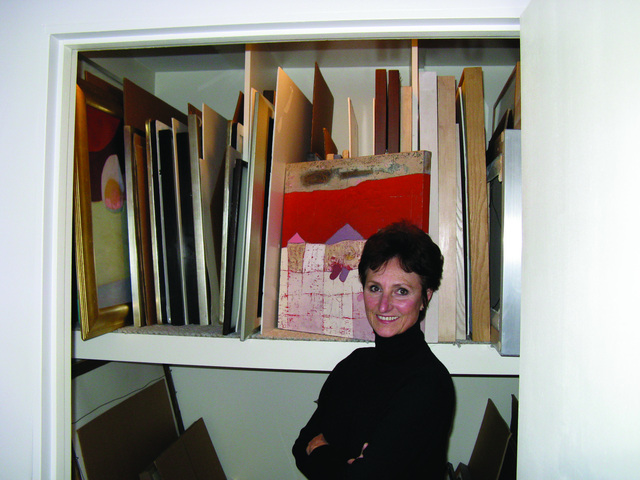Maybe it began with the watercolor landscape of a New Mexican sunset you picked up at a garage sale. Or the antique portrait found while cleaning out your grandmother’s attic. Maybe it’s just something you’ve always wanted to do, and this year you’re gonna make it happen.However the inspiration, you’ve decided to start an art collection. Where the heck do you go from here?To anser this question, I sought out the advice of Pamela P. Michaelis, a 30-year veteran of art buying. Michaelis was in college when she acquired her first piece from a fine art student. Since then, she has amassed a personal collection of original work so large she can’t even hazard a guess as to how many pieces sit in her storeroom. She and her husband, Don, moved to New Mexico from Minnesota 23 years ago and founded The Collector’s Guide, an annual publication about the art for sale in Albuquerque, Santa Fe and Taos. She gave me some advice to pass onto you, fresh-and-eager art fanatic, and I picked up a few tips along the way, too. No. 1: Know Thyself So you want to be art collector? Bravo! You’ve made the first step into the daunting, high-class world known as fine art.Just kidding!The life of an art collector isn’t the stodgy, nebulous realm " The Lifestyles of the Rich and Famous" might make you believe it is. Anyone from college students to realtors to costumer service reps and beyond can partake in the hobby of art collecting. Most important is that you want to make art a part of your life and home."The process of collecting art is a really intimate and subjective activity," Michaelis says. "What’s important in the beginning is taking some time to understand your own taste and quirks, not only what you find truly beautiful but what grabs your attention." The Rule : Don’t buy anything that doesn’t compel you in some way, no matter what value anyone else assigns to it. No. 2: Educate Thyself While the action of collecting is a personal (and often spontaneous) thing, it doesn’t hurt to arm yourself with knowledge. Get out into the art scene and learn about what others involved in the visual arts find appealing."Getting a little experience and education is a really great thing," Michaelis says. Going to art galleries and museums gives a young collector a sense of what is historically important, has real or perceived value, and what new trends are developing, she says. Tour galleries during First Friday Arts Crawls, organized by the Albuquerque Art Business Association, or visit local museums— The Albuquerque Museum, New Mexico Museum of Art in Santa Fe, etc.—that are usually free to New Mexico residents on certain days. The Rule: The more you see, the more developed your taste can become. No. 3: Know Thy Budget Michaelis is a major advocate for buying original pieces. Authentic work, however, can come with a hefty price tag."We live in a place where there is original artwork on every turn and every corner and a lot of it is not very expensive," she says. "The point is, when you buy a piece of original art—not made by an assembly line, but by an individual—you’re making a real intimate connection with a creative force. That is a very important thing."With that in mind, know how much you are willing to spend in one month, one year or on one piece. Original works can range from under $100 to the hundreds of thousands or more, so it’s important to feel comfortable with your budget."If you see a piece of artwork that you absolutely cannot afford," she says, "spend some time really looking at that piece and figuring out what attracts you [to] it. Perhaps you’ll find, in one of these other places—another gallery, a street fair or an artist’s studio—something that has the same elements." The Rule: Don’t bankrupt yourself. You can buy original art that will fit in your budget. No. 4: Get Thee Some Art You’ve got a grasp on what you like and you know what you’re able to spend, now it’s time to get out there and buy some art. Approach your new hobby the same way you tackled the information gathering step by attending as many galleries, art fairs, auctions and the like as you can—time and sanity willing.Follow your gut about buying a piece of art, Michaelis says. If you think it’s a quality piece of work, then it is. There’s no wrong or right way to build a collection, she says, as long as you love what you buy. After all, it’s you who has to look at it every day. The Rule: What rule? Only you know what will and won’t fit in your collection. No. 5: Stretch Thy Dollar As time goes by, your walls will begin to look more like the Louvre than the inside of an Albuquerque adobe, and your skills at art shopping will grow rapidly. Your confidence will help build a strong assemblage and get you the most art for your money.If you’re looking for a bargain, art fairs, flea markets and street shows are a great place to find them, as are local galleries such as the Tamarind Institute, where original prints can start as low as $250 or lower during sales.Often the price on the wall is the lowest the artist is willing to accept at a gallery, Michaelis says. However, it’s not uncommon to agree on a plan to pay over time. "The important thing is to exchange the art," she says. "Artists don’t make art to keep it in their closets. They make art to share." If you’re at an art fair or flea market, it’s OK to negotiate a price, but it would be prudent to let the artist lead the discussion, Michaelis says.Michaelis also advises collectors not to think of their purchases as monetary investments. Unless you’re capable of buying an original Claude Monet painting or Maria Martinez pot, don’t even worry about it, she says."You don’t buy a piece of art for a couple hundred dollars and think, Is this a good investment?" she says. "If you love it, it’s a good investment." The Rule: Buy beautiful art (while sticking to your budget) and your money will always be well spent. No. 6 Clear Thy Walls Now your walls not only look like the Louvre but your closets have begun to resemble the Library of Congress storehouse. Michaelis says she often changes the artwork on display at her home, but every so often comes upon a piece in her collection she knows won’t make it on the wall again."There are always nonprofit organizations that are having art auctions and they need them," she says. Even if you choose another method of purging other than donation, make sure to keep your collection fresh and compelling. The Rule: Art is meant to be seen, not stored. Once you’ve outgrown a piece, it’s time for it to find a new home.











